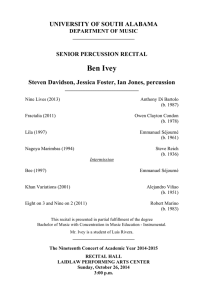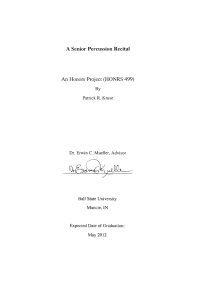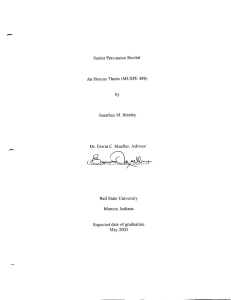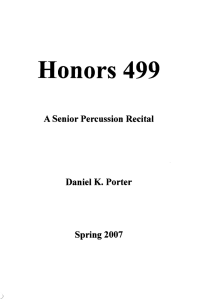Sarah Whybrew Senior Recital Percussion Ball State University
advertisement
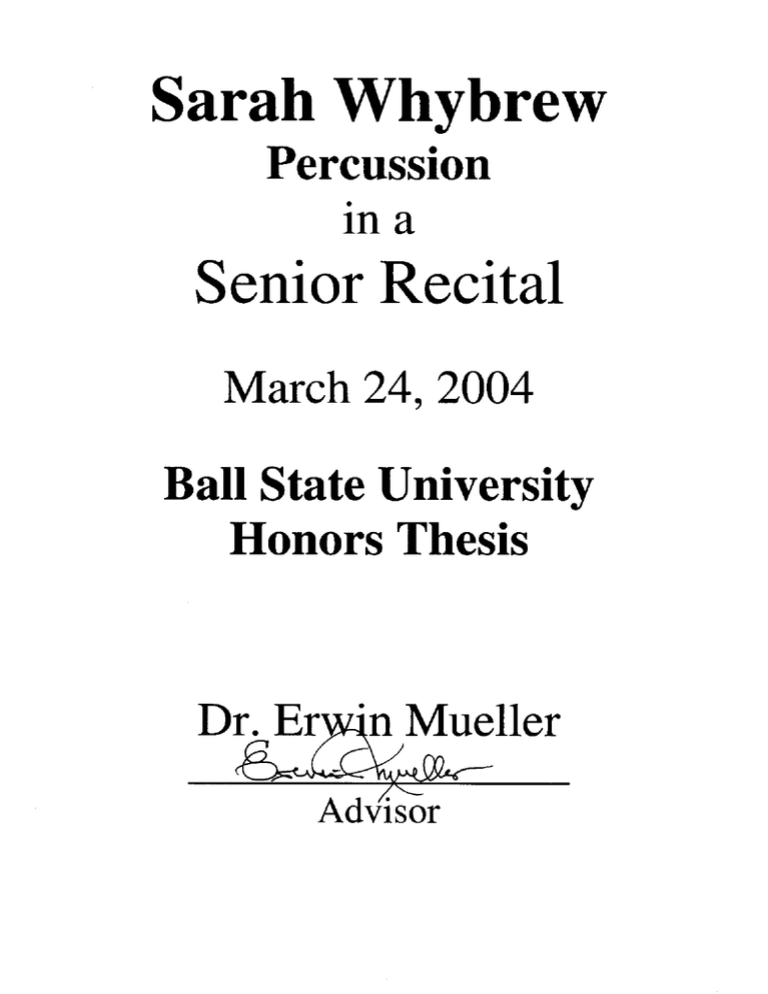
Sarah Whybrew
Percussion
o
In a
Senior Recital
March 24, 2004
Ball State University
Honors Thesis
Dr. Er on Mueller
Advisor
.7tbstract
This compilation represents the senior recital performed by Sarah Whybrew at Ball State
University on March 24, 2004. It describes in detail the process of preparation and selection of music,
including criteria by which each piece was chosen, as well as information concerning performance
techniques.
Each piece required unique skills and understanding of percussion instruments that is
explained in order to give readers a greater appreciation for the instruments and what is required to play
them. Also included is a recording of the recital in compact disc format as well as a copy of the program.
5\cknowfetiiJements
First and foremost I need to thank my Heavenly Father who gives all good gifts. Without His
guidance I would not have had the talent and ability, drive, or courage to complete this recital. Also,
many thanks go to my parents, who have both supported me through years of hauling percussion
equipment around as well as listening to me practice during the first few ear-shattering years. To my
fiance Doug I also owe my gratitude. Thank you for believing in me and enjoying my music; you are the
reason I play. Finally, thank you to my teachers Mr. Chris Richards and Dr. Erwin Mueller for instilling
in me a love of music and giving me the tools to pursue excellence in it, and also to Barbara Mueller,
Michael Pettry, Jason Connell, Cameron Momeni, Danielle Paul, and Rebekah Weaver for being a part of
my senior recital. Thank you all!
Ta6fe of Contents
Introduction ............................................................................................... 1
Preparation and Selection of Music .......................................................... l
Analysis of Performance Techniques ....................................................... 3
Program ..................................................................................................... 6
1
Introduction
When I began playing percussion over eleven years ago, I had no idea where I would go with it, or
for what purpose. As time went by, I found that I enjoyed learning a variety of music and performing in
different arenas.
orchestra (for
Marching band, indoor drum line, concert band, marimba ensemble, orchestra, pit
musicaJ~),
jazz band, and steel drum band as well as solo performing have all played a
pivotal role in shaping my identity as a percussionist.
After my arrival at Ball State University in August of 2000, I prepared for and performed a fulllength freshman recital in May 2001, as well as a junior recital in January 2003. It must be understood
that this senior honors thesis is not only a product of preparation of particular pieces of music, but also a
culmination of past performing experiences such as the ones mentioned above. Just like any other skill
learned in life, performing percussion takes years of practice, patience, and performance. As you read and
listen to the contents of this compilation, keep in mind that this represents more than a one-semester
commitment, it is the final product of eleven years of effort.
Preparation ana Sefection of :Music
As I planned my se!1ior recital, one of the first questions that needed to be answered was "What
pieces do I want to play?" The reason that this was so important is that in approximately one hour of time
I needed to showcase as many different styles, techniques, and abilities as possible. For this reason, I
selected only one piece of music per instrument, and I concentrated on the more standard instruments in
the percussion family.
The resulting selection contains one vibraphone solo (Trilogy), one marimba
concerto with piano accompaniment (Concerto #2 for Marimba and Orchestra), one solo snare suite in
five movements (American Suite for Unaccompanied Snare Drum), one xylophone rag with marimba
ensemble accompaniment (Xylophonia), and one timpani duet with organ accompaniment (Fantasia on
Luther's Hymn).
Now that I had my program, I needed to decide in which order to perform the pieces. Several
considerations came into play with this decision such as: length of the piece, mood of the piece, personal
preference, expected audience reaction, and physical demands of each piece. The final order follows this
logic.
2
I programmed Trilogy first because it is a wonderfully calming piece of music that sets both the
audience and performer at ease. I was relatively comfortable performing this piece, which made it good
to start with to calm any nervousness and to build my self-confidence.
I followed up with Concerto #2 for Marimba and Orchestra for several reasons. This piece was
by far the most challenging of all five, and I wanted to be fresh when I performed it. However, I also
wanted my muscles to be warmed up. Performing it second on the program achieved both goals as well
as the added benefit of coming into it with a good attitude after playing Trilogy.
After the marimba concerto, I drastically changed direction and programmed the snare suite.
Although it is nearly as long as the marimba concerto (I normally would not program two lengthy pieces
back-to-back), it contains a wide variety of styles and playing techniques, keeping the sounds fresh and
interesting to the audience.
Next on the program came Xylophonia. This work is relatively short and very amusing to play
live. After listening to fifteen minutes of snare drum, the audience and performer both are ready for this
welcome change of style.
Last on my program was Fantasia on Luther's Hymn. Of all the pieces I performed during this
recital, this was the most special to me. Based on A Mighty Fortress is Our God, this work provided me
with a way to give back to God all the talent and opportunity that He has blessed me with. The overall
impact of the piece is exactly what I wanted to leave the audience (and myself) with after this
performance, and I knew long ago that it would be the last piece on my program.
Besides the selection and order of the music, another factor contributed to the preparation. One
philosophy that I have learned well from my percussion professor is that more performance is better. For
this reason, preparation for the recital began in February 2003 with the first movement of the marimba
concerto. As I mentioned earlier, this was by far the most challenging piece on the program and therefore
deserved a great deal of time and energy. In addition to that, I also performed this piece many times
before my recital. As other pieces followed, the same idea applied: perform it at least once before the
recital. Interesting notes about this point in the preparation is that I performed the concerto for a concerto
competition at Ball State in September 2003, and also at another competition in Ft. Wayne in November
2003, and also performed the timpani and organ duet at the organist's church.
3
.Jtna{ysis Of Performance Techniques
Trilogy:
In this three-movement vibraphone solo, many techniques and concerns had to be
addressed. First of all, this piece requires the use of four mallets, two in each hand. Vibraphone presents
a unique challenge though in choosing a grip: the accidental bars are on the same plane as the natural bars
(unlike marimba, or even a piano). This changes the way that one's hands move across the bars with
mallets, and avoiding odd contortions of the arms and wrists is always a high priority. My favorite grip
for vibraphone, Burton grip, is the one I chose for this piece. Burton grip allows for natural motions and
retains powerful strokes since your hands are in a natural position.
The other technique on vibraphone that stands out (as opposed to other keyboard instruments) is
the use of the pedal. Under the metal bars, there is a felt bar that runs the entire length of the keyboard
and dampens the sound when the pedal is up. When one depresses the pedal, the sound of each bar is
allowed to resonate. The challenges produced with this tend to focus on how to position one's body over
the instrument in such a way that the notes can be played comfortably while still using the pedal properly.
When to depress the pedal can also be a concern, as it was in this piece. For the most part, I relied on
chord structure and intuition to guide my decisions about when to start and stop the sound (this is much
like breathing and phrasing to a wind instrument).
Concerto #2 for Marimba and Orchestra: I performed this concerto with a piano accompaniment
instead of a full orchestra (which is much more difficult to schedule) and in the process was able to
display my ability to play with accompaniment. One thing I learned from this work is that no matter what
a piece sounds like by itself, the full idea is only expressed when all the parts are being played. For this
piece, I chose to use Burton grip again since it required four mallets. Plus, the first and third movements
are so powerful in concept that I needed a grip in which I could bear down on the instrument more. Points
of interest and difficulty in this piece include the fast runs in the first and third movements, one-handed
roles in the second movement, playing with the stick-end of the mallet instead of the yarn head in the third
movement, and mandolin roles in the third movement.
Independence of hands is a necessity in
performing this piece, especially since it is characteristic of Ney Rosauro to compose rhythmic ideas that
are asymmetrical and then layer them with something more common in three or four.
The other technical challenge in this piece is taking the raw materials of playing the notes and
transforming it into heart-felt music. This is achieved by slight variations in dynamics, tempo, and how
the bars are struck. Musicality is something that is learned over a long period of time, and the preparation
of this piece was truly years in the making.
4
American Suite for Unaccompanied Snare Drum: This suite is so full of technical ideas and
challenges that one could write a full-length paper on it alone. However, I will just provide some of the
basics.
First of all, imbedded in these five movements are all forty of the Percussive Arts Society
International Drum Rudiments. In fact, Guy G. Gauthreaux II found a way to put all forty in the second
movement alone!
The first movement sets up the motives for further development, and for this movement I used
matched grip in order to produce an even tone in the snare drum.
The second movement requires a high skill level in rudimentary drumming, and thus I chose to use
traditional grip for it. One point of interest here is that even though all forty rudiments are used, they are
structured in such a way that they still use the motives created in the first movement.
The style of the third movement is quite different, as it is based on a jazz swing pattern and uses
brushes almost exclusively. The "swish" sound is produced by swirling one of the brushes around the
head of the snare and leaving the other hand to produce accents. The middle section of this movement is
challenging in that the high-speed sixteenths must be very controlled to produce a difference in sound
between the regular notes and the accented ones, especially since the wire brushes wobble quite a bit.
A Latin feel is created during the fourth movement, and after much experimentation I decided to
use timbale beaters for this movement. The performance techniques of striking various parts of the drum
very much resemble timbale playing. The challenge here was not really learning the rhythms so much as
learning the various techniques of striking the drum. In addition to all these new techniques, Gauthreaux
includes a section where activating and deactivating the snares on the bottom of the drum produce the
desired sound. The irony here is that during most performances (especially in an orchestral setting) the
sound made by activating the snares is definitely not desirable.
In the fifth movement, the style changes again to one of advanced modem rudimental drumming.
Independence of hands, skill in deciphering complex rhythms, and ability to play unexpected patterns
(such as the one at the beginning where the stick is rocked back and forth from rim to head) are required.
Use of matched grip during this movement seemed the most practical since traditional grip would require
unnatural contortion ofthe wrist to play some of the required patterns.
Xylophonia: Besides the lightheartedness of this piece, the real technique emphasized here is
accuracy. The bars of a xylophone are normally much thinner than that of a marimba, and the music
moves very quickly. Most xylophone music, this piece included, tends to be very tonal as well, making
any mistakes very noticeable. Another unexpected technique that I had to learn for this piece was how to
playa duck call. While simply blowing on the mouthpiece could produce an interesting sound, I needed
5
some variety to fill the time in an exciting way. It would be very difficult to describe exactly what I did
since I am no wind player, but I do know that I created the desired effect: amusement.
Fantasia on Luther's Hymn: This work is a true duet in the sense that it is difficult for both the
organist and the timpanist. My analysis though will only focus on the timpani part. The piece begins
with a long and tedious cadenza in which the most challenging aspects are accuracy of rhythm and
musicality. When the main theme is first stated, the shift of difficulty goes to that of determining proper
pitch. Timpani are tuned by pedals that control the tension of the head; therefore, all tuning is done by the
feet. Of all the timpani pieces I have played, this is the only one in which I was forced to sit and play
(because my feet were so busy!). However, the reward of hearing one of my favorite themes played in
tune was well worth the challenge.
As the piece progresses, there is a section in the middle in which the composer allows for
improvisation. During the first two parts of this section, I did in fact choose to improvise, both with the
mallet head in the center of the drum (producing a dead tone) and with the stick -end of the mallet
(producing a very sharp "twang" on the head). However, during the third part of the improvisation, I
chose to incorporate the tune from the doxology known to many Protestants as yet another way to give
praise to God.
The final section of the piece requires a high level of communication between both performers in
order to hit chords and cut off sound together. The finale is one of the most powerful that I have ever
played, and the challenge of balancing the sound needed to be overcome. The final outcome during the
recital was very satisryi:Jg.
SARAH WHYBREW
percussion
in a
SENIOR RECITAL
with
Barbara Mueller, piano
Michael Pettry, organ
and
Jason Connell, Cam ron Momeni, Danlelle Paul,
Rebekah Weaver, marimbas
ell
~
:.::
~
Trilogy .................................................................................................. Tim Huesgen
A Vision in a Dream
A Fragment
With a Mazy Motion
~ co~.ce:a~~ ~~~~~;;~aH~~~ 3~~~~!~a .............................................. Ney Rosauro
b
.~
II. Reflections and Dreams
III. Walking on Clouds
I....-~
American Suite for Unaccompanied Snare Drum .................. Guy G. Gauthreaux II
~1.
~
~
~
Q3
~
II.
III.
IV.
V.
Xylophonia ................................................................................................ Joe Green
arr. Bob Becker
Fantasia on Luthe~s Hymn ........................................ " ................... Stanley Leonard
Sarah Whybrew is a student of Erwin Mueller
and a member of Sigma Alpha Iota,
Intemational Fraternity for women in the field of music.
PRUIS HALL
Wednesday, March 24, 2004
8:00 p.m.
Series LVIII
Number 150
In keepIng with copyright and arli.t aglflement., u.e of lflcorrJing
and photographic device. i. not pennitted by other than approved unlversNy personnel.
We IfIque.t your coopelflUon.
